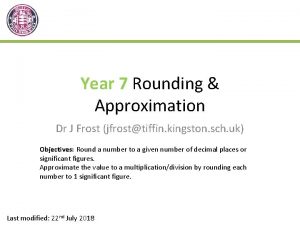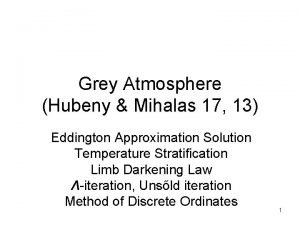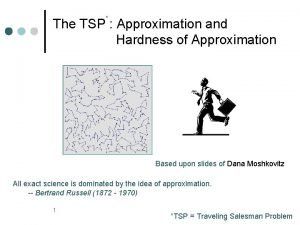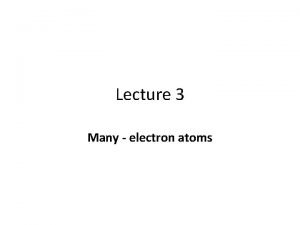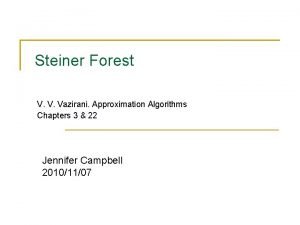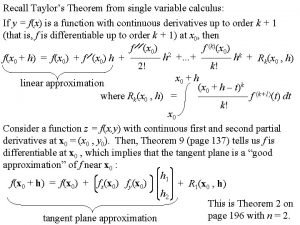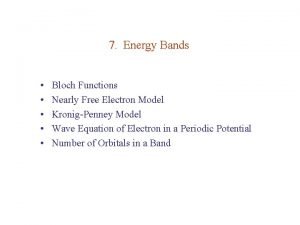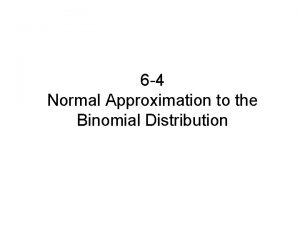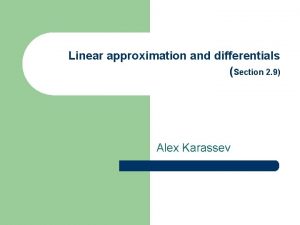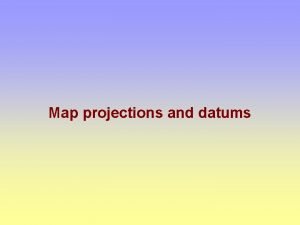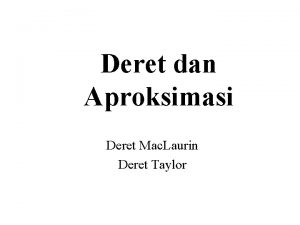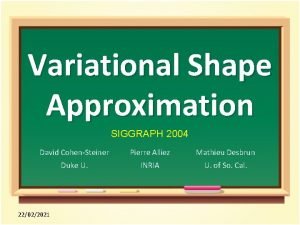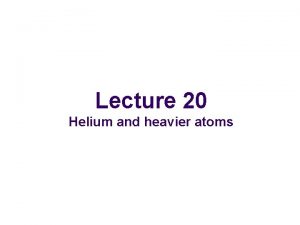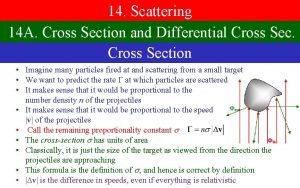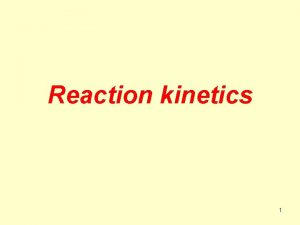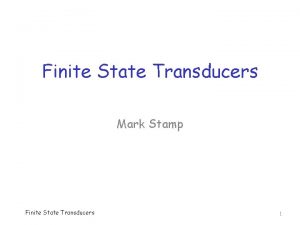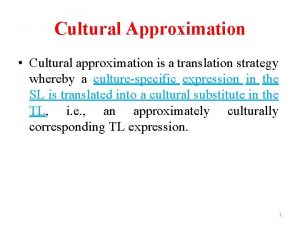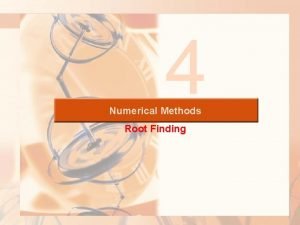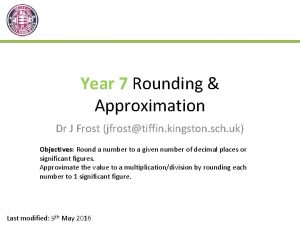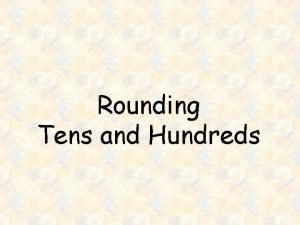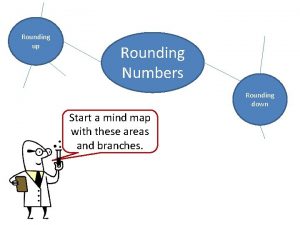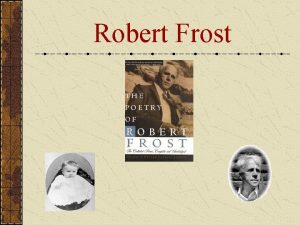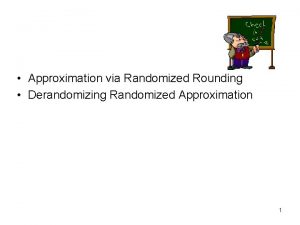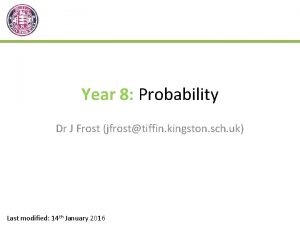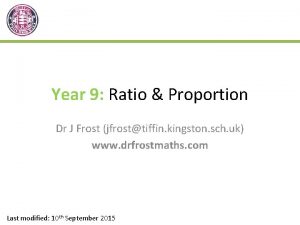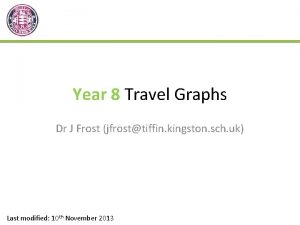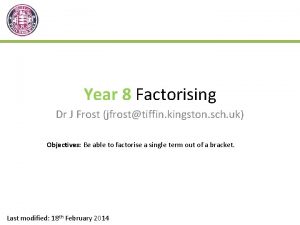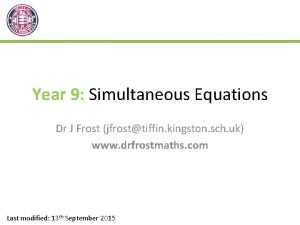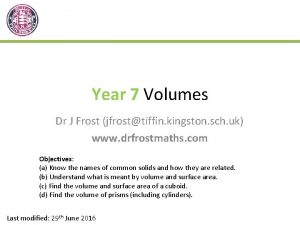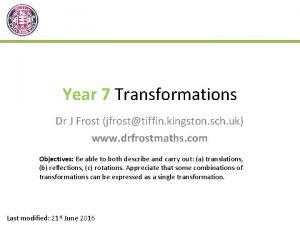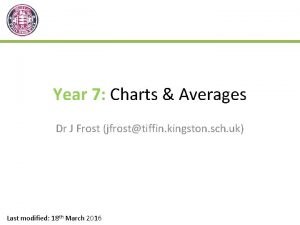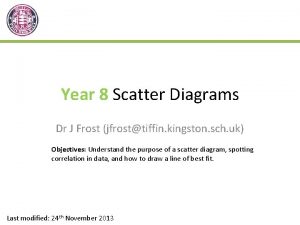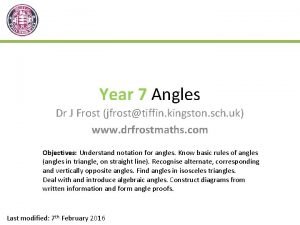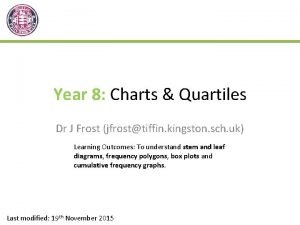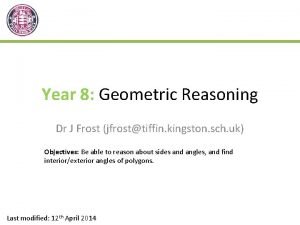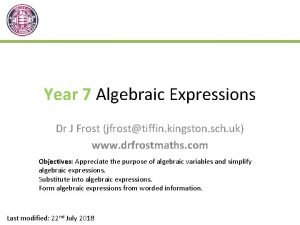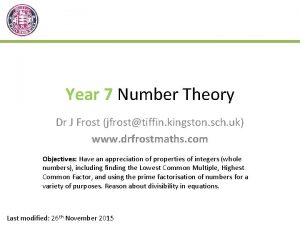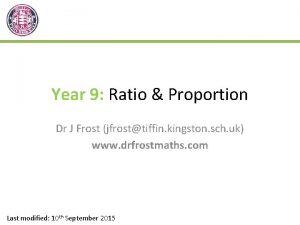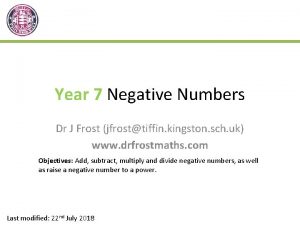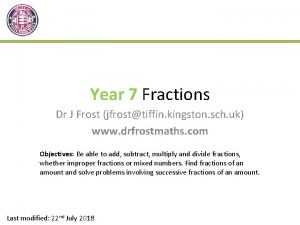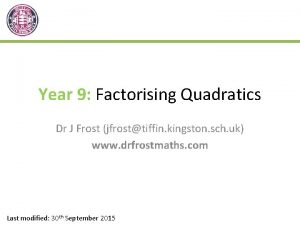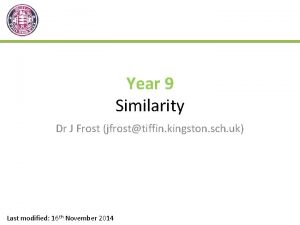Year 7 Rounding Approximation Dr J Frost jfrosttiffin

















![STARTER : : Approximation [JMC 2010 Q 14] The Severn Bridge has carried just STARTER : : Approximation [JMC 2010 Q 14] The Severn Bridge has carried just](https://slidetodoc.com/presentation_image/02885a64b66b6398ca82ddec6dabe731/image-18.jpg)



![Maths Challenge Strategies ? ? [JMC 2000 Q 16] A book has 256 pages Maths Challenge Strategies ? ? [JMC 2000 Q 16] A book has 256 pages](https://slidetodoc.com/presentation_image/02885a64b66b6398ca82ddec6dabe731/image-22.jpg)



- Slides: 25

Year 7 Rounding & Approximation Dr J Frost (jfrost@tiffin. kingston. sch. uk) Objectives: Round a number to a given number of decimal places or significant figures. Approximate the value to a multiplication/division by rounding each number to 1 significant figure. Last modified: 22 nd July 2018

www. drfrostmaths. com Everything is completely free. Why not register? Register now to interactively practise questions on this topic, including past paper questions and extension questions (including UKMT). Teachers: you can create student accounts (or students can register themselves), to set work, monitor progress and even create worksheets. With questions by: Dashboard with points, trophies, notifications and student progress. Teaching videos with topic tests to check understanding. Questions organised by topic, difficulty and past paper.

Rounding to decimal places Round this number to 1 decimal place. Step 1: Imagine underlining up to the required accuracy, counting from the decimal point. Do It > Step 2: Look at the number after the last underlined. If 5 or more, we increase the last number by 1 Do It > (ensure you propagate left any carries) Step 3: Check that you’ve actually given the number to the required accuracy. (If it’s 1 dp, then ensure there’s one digit after the decimal point!) ?

More Examples Round this number to: • • • The nearest whole: 1 dp: 2 dp: 3 dp: 4 dp: 42 ? 42. 5 42. 49? ? 42. 4905 42. 490 seems to be the same as 42. 49. But why would the latter be wrong? The 0 at the end gives extra information. It’s telling us that the thousandth’s digit is ? 0, whereas if we put 42. 49, we’re leaving the thousandths digit unspecified. Step 1: Imagine underlining up to the required accuracy, counting from the decimal point. Step 2: Look at the number after the last underlined. If 5 or more, we increase the last number by 1 (ensure you propagate left any carries) Step 3: Check that you’ve actually given the number to the required accuracy. (If it’s 1 dp, then ensure there’s one digit after the decimal point!)

A Harder One… Round this number to: • 1 dp: • 2 dp: 50. 0? ? 49. 99 Step 1: Imagine underlining up to the required accuracy, counting from the decimal point. Step 2: Look at the number after the last underlined. If 5 or more, we increase the last number by 1 (ensure you propagate left any carries) Step 3: Check that you’ve actually given the number to the required accuracy. (If it’s 1 dp, then ensure there’s one digit after the decimal point!)

Test Your Understanding A B 1 dp 2 dp 3 dp 4 dp 7. 7 ? 7. 7403? 13. 5 ? 13. 50 ? 13. 496? ? 13. 4958 N 1 dp 2 dp 3 dp 10. 0? 9. 990 ? 5 dp 6 dp 7 dp ? 9. 99010 ? 9. 9900990 4 dp 9. 9901 ? 8 dp ? 9. 99009901

Significant Figures Suppose it’s your 11 th birthday party and 16439 people attend. If you were casually saying to someone how many people came, what figure might you quote? We might say 16000 people came. ? IT’S MY Y BIRFDA We seem to have taken ‘ 2 digits’ of accuracy. However, unlike 2 dp, where we’d count 2 digits from the decimal point, we’re counting digits from the start of the number. We say we’ve rounded to 2 significant figures. Round 375 694 to 3 significant figures. This is exactly the same as rounding to decimal places, except: (a) We start counting from the first non-zero digit (not the decimal point). (b) We have to ‘zero-out’ any digits before the decimal point not used. (Otherwise we would have changed the place value of the digits we kept) ?

Examples Round 17. 4864 to: • • 1 sf: 20 2 sf: 17 3 sf: 17. 5 4 sf: 17. 49 ? ? Round 49 329 to: • • 1 sf: 50 000? 2 sf: 49 000? 3 sf: 49 300? 4 sf: 49 330? Round 0. 0429028 to: • • 1 sf: 0. 04 ? 2 sf: 0. 043 ? 3 sf: 0. 0429? 4 sf: 0. 04290 ?

Test Your Understanding Vote with the coloured cards in your diaries (use the front for blue)

Round 7494. 4924 to 2 sf.

Round 3555. 5555 to 3 dp.

Round 540 693 to 3 sf.

Round 0. 04046 to 2 dp.

Round 0. 04046 to 2 sf.

Round 69311 to 1 sf.

Round 3999. 9961 to 2 dp.

Exercise 1 Complete the following table. 1 123. 456 144. 402 8888. 888 437. 3946 987. 654 2 dp 1 sf 2 sf 3 sf 123. 5? 123. 46 ? 100 ? 123 ? 8888. 9 ? 8888. 89 ? 9000? 8900? 8890? 144. 4? 437. 4? 987. 7? 3 809 830. 492 3809830. 5 ? 1. 98043 2. 0 4. 80808 99. 009900 2 1 dp ? 4. 8 ? 99. 0 ? 144. 40 ? 437. 39 ? 987. 65 ? 3809830. 49 ? ? 4. 81 ? 99. 01? 1. 98 100 ? 140 ? 400 ? 440 ? 1000? 4 000 ? ? 5 ? 100 ? 2 3 800 000 ? 2. 0 4. 8 99 ? ? N 990 ? ? ? ? ? 144 ? 437 ? 988 ? 3 810 000 ? 1. 98? 4. 81? 99. 0?
![STARTER Approximation JMC 2010 Q 14 The Severn Bridge has carried just STARTER : : Approximation [JMC 2010 Q 14] The Severn Bridge has carried just](https://slidetodoc.com/presentation_image/02885a64b66b6398ca82ddec6dabe731/image-18.jpg)
STARTER : : Approximation [JMC 2010 Q 14] The Severn Bridge has carried just over 300 million vehicles since it was opened in 1966. On average, roughly how many vehicles is this per day? A 600 B 2 000 C 6 000 D 20 000 E 60 000 A B C D E [JMC 2003 Q 15] It was reported recently that, in an average lifetime of 70 years, each human is likely to swallow about 8 spiders while sleeping. Supposing that the population of the UK is around 60 million, what is the best estimate of the number of unfortunate spiders consumed in this way in the UK each year? A 50 000 B 600 000 C 7 000 D 80 000 E 900 000 A B C D E

! To approximate, round each number to 1 significant figure first. ‘approximately equal to’ ? ?

Dividing by numbers less than 1. ? ?

Test Your Understanding ? ?
![Maths Challenge Strategies JMC 2000 Q 16 A book has 256 pages Maths Challenge Strategies ? ? [JMC 2000 Q 16] A book has 256 pages](https://slidetodoc.com/presentation_image/02885a64b66b6398ca82ddec6dabe731/image-22.jpg)
Maths Challenge Strategies ? ? [JMC 2000 Q 16] A book has 256 pages with, on average, 33 lines on each page and 9 words on each line. Which of the following is the best approximation to the number of words in the book? A 64 000 B 68 000 C 72 000 D 76 000 E 80 000 A B C D E

Test Your Understanding A B C D E

Exercise 2 4 1 ? ? ? a b c d e 2 ? a b ? ? c d e ? 5 ? ? 6 ? ? 7 3 ? ? ? 8 ? ?

Exercise 2 9 ? 10 ? 11 ?
 Rounding dr frost
Rounding dr frost Primary leavers poem
Primary leavers poem Eddington approximation grey atmosphere
Eddington approximation grey atmosphere Tsp approximation
Tsp approximation Orbital approximation
Orbital approximation Weak potential
Weak potential Gradual channel approximation
Gradual channel approximation Approximation algorithms vazirani
Approximation algorithms vazirani Taylor's theorem for single variable
Taylor's theorem for single variable Nearly free electron approximation
Nearly free electron approximation Normal approximation calculator
Normal approximation calculator Linear approximation
Linear approximation Fully polynomial time approximation scheme
Fully polynomial time approximation scheme Flat earth map projection
Flat earth map projection Approximation
Approximation Taylor series error
Taylor series error Linear approximation 2 variables
Linear approximation 2 variables Variational shape approximation
Variational shape approximation Orbital approximation helium
Orbital approximation helium First born approximation
First born approximation Poisson approximation
Poisson approximation A storyboard is an approximation of the final commercial.
A storyboard is an approximation of the final commercial. Steady state approximation
Steady state approximation Fffuf
Fffuf Cultural approximation
Cultural approximation Successive approximation method in numerical methods
Successive approximation method in numerical methods
